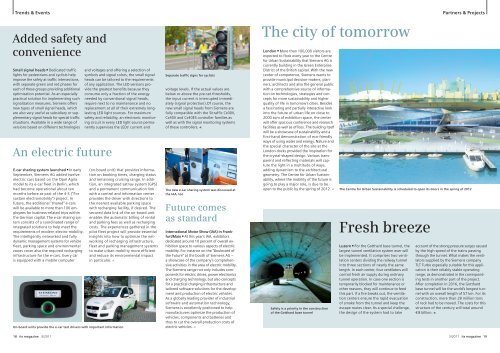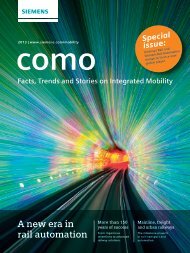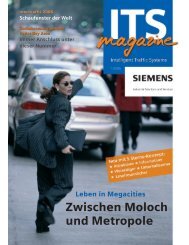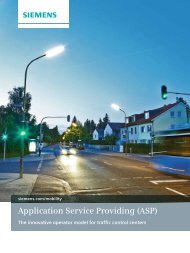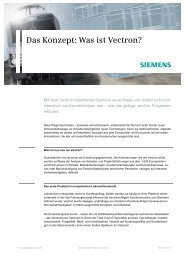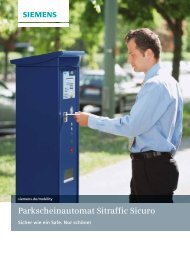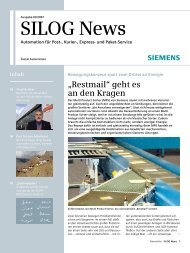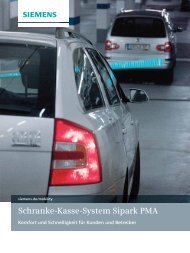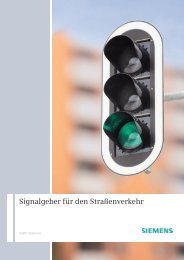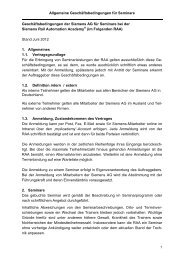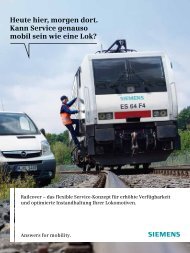Create successful ePaper yourself
Turn your PDF publications into a flip-book with our unique Google optimized e-Paper software.
Trends & Events Partners & Projects<br />
Added safety and<br />
convenience<br />
Small signal heads n Dedicated traffic<br />
lights for pedestrians and cyclists help<br />
improve the safety at traffic intersections,<br />
with separate green and red phases for<br />
each of these groups providing additional<br />
optimization potential. As an especially<br />
practical solution for implementing such<br />
signalization measures, <strong>Siemens</strong> offers<br />
new types of small signal heads, which<br />
are also very useful as subsidiary or supplementary<br />
signal heads for special traffic<br />
situations. Available in a wide range of<br />
versions based on different technologies<br />
An electric future<br />
E-car sharing system launched n In early<br />
September, <strong>Siemens</strong> AG added twelve<br />
electric cars based on the Opel Agila<br />
model to its e-car fleet in Berlin, which<br />
had become operational about ten<br />
months before as part of the 4-S (“For<br />
sustain electromobility”) project. In<br />
future, the additional “shared” e-cars<br />
will be available to more than 100 employees<br />
for business-related trips within<br />
the German capital. The e-car sharing system<br />
consists of a coordinated range of<br />
integrated solutions to help meet the<br />
requirements of modern electro-mobility.<br />
The intelligently networked and fully<br />
dynamic management systems for vehicle<br />
fleet, parking space and environmental<br />
zones cover also the required recharging<br />
inf ra structure for the e-cars. Every car<br />
is equipped with a mobile computer<br />
and voltages and offering a selection of<br />
symbols and signal colors, the small signal<br />
heads can be tailored to the requirements<br />
of any application. The LED versions provide<br />
the greatest benefits because they<br />
consume only a fraction of the energy<br />
needed by conventional signal heads,<br />
require next to no maintenance and no<br />
replacement at all of their extremely longlasting<br />
LED light sources. For maximum<br />
safety and reliability, an electronic monitoring<br />
circuit in every LED light source permanently<br />
supervises the LEDs‘ current and<br />
On-board units provide the e-car test drivers with important information<br />
(on-board unit) that provides information<br />
on booking times, charging status<br />
and remaining cruising range. In addition,<br />
an integrated satnav system (GPS)<br />
and a permanent communication link<br />
with a control and information center<br />
provides the driver with directions to<br />
the nearest available parking space<br />
with recharging facility, if desired. The<br />
secured data link of the on-board unit<br />
enables the automatic billing of rental<br />
and parking fees as well as recharging<br />
costs. The experiences gathered in the<br />
pilot fleet project will provide essential<br />
insights into how to optimize the networking<br />
of recharging infrastructure,<br />
fleet and parking management systems<br />
to make urban mobility more efficient<br />
and reduce its environmental impact<br />
in particular. «<br />
Separate traffic signs for cyclists<br />
voltage levels. If the actual values are<br />
below or above the pre-set thresholds,<br />
the input current is interrupted immediately<br />
(signal protection).Of course, the<br />
new small signal heads from <strong>Siemens</strong> are<br />
fully compatible with the Sitraffic Cx00V,<br />
Cx40V and Cx40ES controller families as<br />
well as with the signal monitoring systems<br />
of these controllers. «<br />
The new e-car sharing system was discussed at<br />
the IAA, too<br />
Future comes<br />
as standard<br />
International Motor Show (IAA) in Frankfurt/Main<br />
n At this year’s IAA, exhibitors<br />
dedicated around 10 percent of overall exhibition<br />
space to various aspects of electric<br />
mobility. For instance on the “Boulevard of<br />
the Future“ at the booth of <strong>Siemens</strong> AG –<br />
a showcase of the company’s comprehensive<br />
activities in the area of electric mobility.<br />
The <strong>Siemens</strong> range not only includes components<br />
for electric drives, power electronics<br />
and charging technology, but also concepts<br />
for a practical charging infrastructure and<br />
tailored software solutions for the development<br />
and production of electric vehicles.<br />
As a globally leading provider of industrial<br />
software and automation technology,<br />
<strong>Siemens</strong> is excellently positioned to help<br />
manufacturers optimize the production of<br />
vehicles, components and batteries and<br />
thus to cut the overall production costs of<br />
electric vehicles. «<br />
The city of tomorrow<br />
London n More than 100,000 visitors are<br />
expected to flock every year to the Centre<br />
for Urban Sustainability that <strong>Siemens</strong> AG is<br />
currently building in the Green Enterprise<br />
District of the British capital. With the new<br />
center of competence, <strong>Siemens</strong> wants to<br />
provide municipal decision-makers, planners,<br />
architects and also the general public<br />
with a comprehensive source of information<br />
on technologies, strategies and concepts<br />
for more sustainability and higher<br />
quality of life in tomorrow’s cities. Besides<br />
a fascinating and partially interactive look<br />
into the future of urban life on close to<br />
2000 sqm of exhibition space, the center<br />
will offer spacious conference and research<br />
facilities as well as offices. The building itself<br />
will be a showcase of sustainability and a<br />
first-hand demonstration of eco-friendly<br />
ways of using water and energy. Nature and<br />
the special character of the site at the<br />
London docks provided the inspiration for<br />
the crystal-shaped design. Various transparent<br />
and reflecting materials will capture<br />
the light in a multitude of ways,<br />
adding dynamism to the architectural<br />
geometry. The Centre for Urban Sustainability,<br />
where the mobility of the future is<br />
going to play a major role, is due to be<br />
open to the public by the spring of 2012. «<br />
Safety is a priority in the construction<br />
of the Gotthard base tunnel<br />
The Centre for Urban Sustainability is scheduled to open its doors in the spring of 2012<br />
Fresh breeze<br />
Luzern n For the Gotthard base tunnel, the<br />
largest tunnel ventilation system ever will<br />
be implemented. It comprises two ventilation<br />
centers dividing the railway tunnel<br />
into three sections of nearly the same<br />
length. In each center, four ventilators will<br />
control fresh air supply during ordinary<br />
tunnel operation. In case one section is<br />
temporarily blocked for maintenance or<br />
other reasons, they will continue to feed<br />
this part. If a fire breaks out, the ventilation<br />
centers ensure the rapid evacuation<br />
of smoke from the tunnel and keep the<br />
escape routes clear. As a special challenge,<br />
the design of the system had to take<br />
account of the strong pressure surges caused<br />
by the high speed of the trains passing<br />
through the tunnel. What makes the ventilators<br />
supplied by the <strong>Siemens</strong> company<br />
TLT Turbo especially suitable for this application<br />
is their reliably stable operating<br />
range, as demonstrated in the corresponding<br />
tests in another part of the project.<br />
After completion in 2016, the Gotthard<br />
base tunnel will be the world’s longest tunnel<br />
with an overall length of 57 km. For its<br />
construction, more than 28 million tons<br />
of rock had to be moved. The costs for this<br />
structure of the century will total around<br />
€ 8 billion. «<br />
18 its magazine 3/20<strong>11</strong> 3/20<strong>11</strong> its magazine 19


